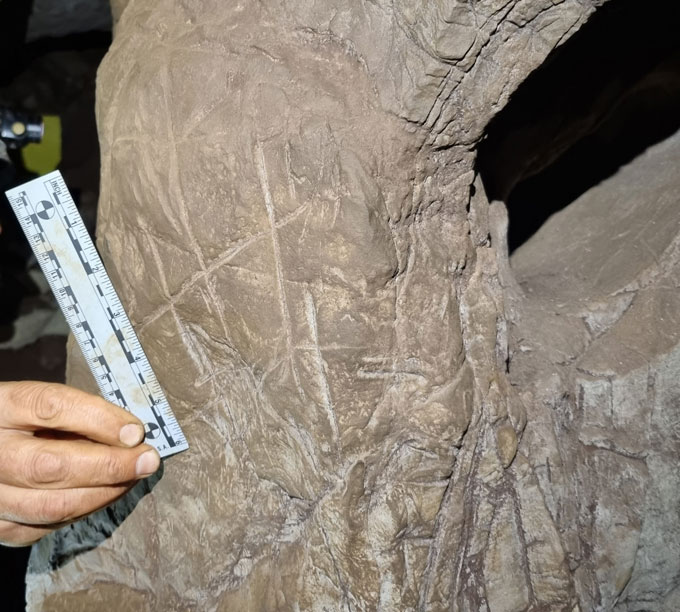This post was originally published on this site
An extinct, small-brained hominid known as Homo naledi intentionally buried its dead in two underground cave chambers 160,000 years or more before the earliest evidence of deliberate interments by Homo sapiens or Neandertals, researchers say. But that conclusion has already generated skepticism and calls for more thorough investigations of the new South African finds.
H. naledi, which lived in southern Africa between roughly 335,000 and 236,000 years ago, also engraved marks on the side of a corridor and entryway that connects the adjacent cave chambers, contends an international team led by paleoanthropologist Lee Berger of Wits University in Johannesburg, South Africa (SN: 5/9/17). Many engravings consist of isolated lines or lines that form crosshatches, squares, triangles, crosses and X shapes.
If correct, Berger and colleagues’ interpretation of their discoveries indicates that an ancient Homo species with an orange-sized brain — which possibly displayed humanlike features — engaged in mortuary and symbolic activities often thought to have emerged only in larger-brained species such as H. sapiens (SN: 4/25/17).
“These are remarkable discoveries of a [Homo] species that had brains one-third the size of ours yet buried their dead and carved meaning-making symbols on cave walls,” Berger said at a press conference on June 1. He and colleagues report the new H. naledi findings in three bioRxiv.org papers accepted for publication in eLife.

The oldest known H. sapiens grave dates to about 78,300 years ago in Africa (SN: 5/5/21). Contested Neandertal graves in Iraqi Kurdistan are roughly 70,000 to 60,000 years old (SN: 2/18/20). In South Africa’s Blombos Cave, a crosshatched design on a rock dates to around 73,000 years ago and geometric patterns incised on pigment pieces date to as early as about 100,000 years ago (SN: 9/12/18; SN: 6/12/09).
Some researchers consider the new evidence inadequate to confirm that H. naledi interred its own in cave graves. And there is no way to determine whether H. naledi or perhaps later H. sapiens visitors to the underground caves — part of South Africa’s Rising Star Cave System, about 40 kilometers west of Johannesburg — created the undated engravings found by Berger’s group.
“I think that deliberate burial of the dead by Homo naledi is clear, although it is unlikely that the evidence so far presented will satisfy all scholars,” says archaeologist Michael Petraglia of Griffith University in Brisbane, Australia, who is not part of Berger’s team.
One objection comes from paleoanthropologist María Martinón-Torres, director of the Spanish National Research Center on Human Evolution in Burgos. She suspects that disconnected skeletal parts described in the new papers accumulated either after bodies of the dead that had been placed in cave shafts later fell through or had been left at the back of underground caves. Trampling or other H. naledi activities in caves could eventually have produced fragmentary sets of fossils uncovered by Berger’s group, says Martinón-Torres, who along with Petraglia studied the oldest known H. sapiens burial in Africa.
It’s possible that periodic water seepage into the underground caves helped to move partial or complete H. naledi corpses down sloping cave floors until they came to rest in natural depressions that Berger’s team suggests are intentional burial sites, says archaeologist Paul Pettitt of Durham University in England.
Previous suggestions that H. naledi lit campfires and deposited comrades’ dead bodies in passages that descend into underground chambers have also been criticized as lacking definitive evidence (SN: 12/2/22; SN: 11/4/21).

In 2018, Berger’s team excavated what they consider the skeletal remains of an adult H. naledi whose body was placed in a shallow pit that was dug in the Dinaledi Chamber, a cave space in the Rising Star Cave System where H. naledi fossils have previously been found. Bones of the newly unearthed individual became detached over time as the body decomposed in dry sediment that collapsed in on it, the scientists say. That process, or perhaps the digging of other burials in the chamber, caused bone fragments of at least one other individual to enter the grave.
A second set of fragmentary H. naledi fossils found in another shallow pit in the Dinaledi Chamber have not yet been analyzed.
In 2017, the scientists also removed fragile H. naledi remains encased in three blocks of sediment from a small section of an adjacent underground space dubbed the Hill Antechamber.
CT scans of the blocks have identified partial skeletal remains of a roughly 13-year-old H. naledi whose body, curled in a fetal position, was placed in a shallow, dug-out depression and covered with dirt, the scientists say. Scattered teeth of two other H. naledi individuals were also detected in this block, possibly entering via sediment disturbances or as H. naledi buried others in the Hill Antechamber, the team suspects.
A crescent-shaped stone identified among scanned H. naledi fossils includes a point, sharp edges and other signs of having been an implement of some kind, the investigators note. But scans of that stone reveal no clear indications of intentional modifications, Pettitt says. This find should be examined more closely after it’s removed from surrounding sediment, he says.
H. naledi must have used a tool capable of chiseling through extremely hard rock to engrave lines and designs found on the sides of a corridor and entryway into the Hill Antechamber, Berger said at the news conference. Later Stone Age cave art of Neandertals and H. sapiens includes similar geometric drawings. There is no evidence that present-day cavers have created comparable engravings anywhere in the Rising Star Cave System, he said.
But the underground cave engravings remain undated. There is no way to know whether people reached the cave chambers within the past few thousand years and carved those wall patterns, Pettitt says.
H. naledi may have had access to larger openings into the Dinaledi Chamber than exist now, says zooarchaeologist Aurore Val of Aix-Marseille University in France (SN: 4/19/16). Although the new reports don’t clearly establish that H. naledi dug cave graves and created rock designs, members of this ancient species were “doing something different and unusual” in the Rising Star Cave System, Val says.
